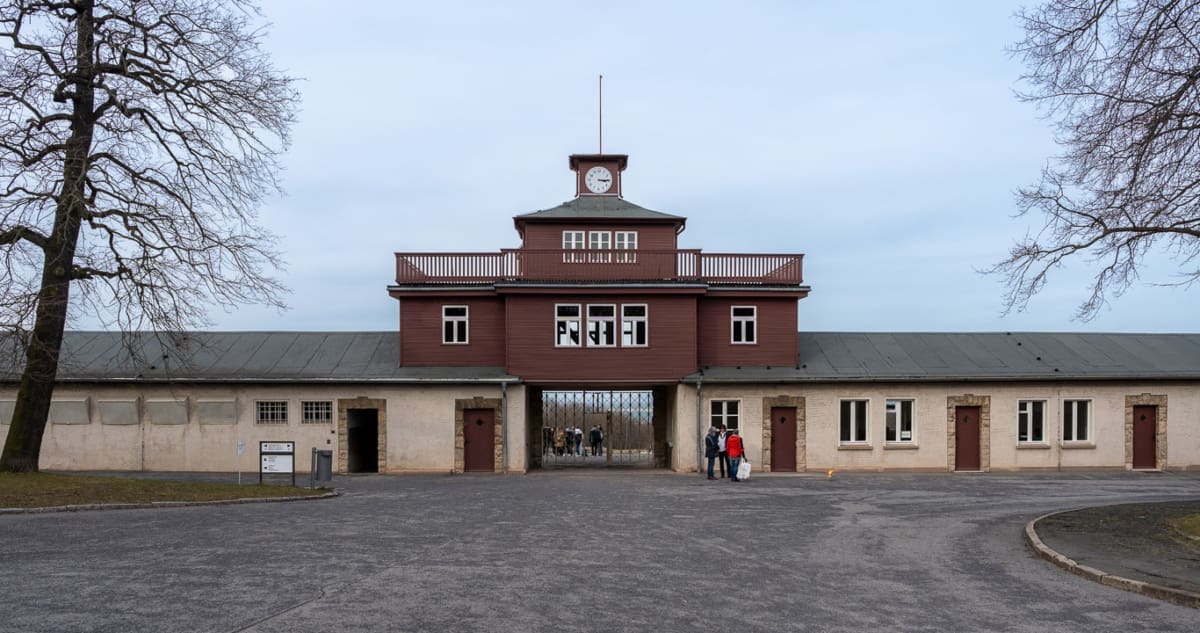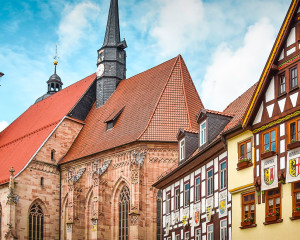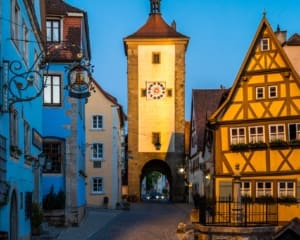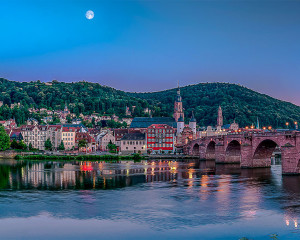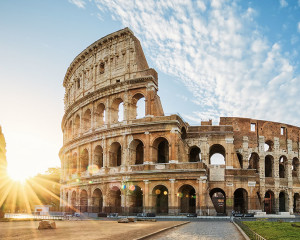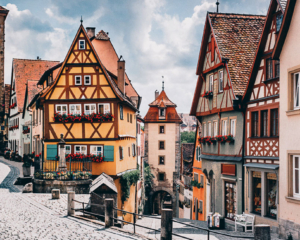Remembering a dark past: a visit to the Buchenwald Weimar memorial site
The largest concentration camp on German soil at the end of the war was located in Buchenwald on the Ettersberg, 10 km outside Weimar. More than 56,000 people died here as a result of medical experiments, torture or starvation. More than 8,000 Soviet prisoners of war were murdered behind their backs in a special execution facility. In total, over 250,000 people were imprisoned in the concentration camp on the Ettersberg and its 136 satellite camps. The SS forced the prisoners to perform forced labor, particularly for the German arms industry.
The former concentration camp is now a memorial site that anyone can visit free of charge. Buchenwald should be on everyone's list of places of interest in Germany that they should visit at least once in their lifetime.
I visited the memorial on a spring-like February day. There is an oppressive silence, individual visitors and school classes move slowly and gloomily across the grounds. The suffering that so many people had to experience here is unimaginable.
You can visit the concentration camp, which was built in July 1937, including the former prisoner camp, SS area with dog kennels, crematorium, small camp, Soviet special camp no. 2, the museum and the bell tower with three mass graves and other outdoor facilities every day as part of a guided tour or via an audio app (on your cell phone, with a map).
It was a very informative and of course, depressing visit. You learn a lot about the suffering and life in the camp on site. The size is particularly impressive and terrifying. A must for everyone, as it is an important place of remembrance and remembrance of the victims of National Socialism. Admission is free.
Note, as many people ask: According to current research, there were no gas chambers in the Buchenwald concentration camp or its sub-camps.
History of the Buchenwald concentration camp
The Buchenwald concentration camp was established on the Ettersberg near Weimar in 1937 and was one of the largest concentration camps in Germany. Volunteer personnel from the SS Totenkopfstandarte 3 "Thüringen", a special unit, were recruited for the camp. They were supposed to embody a new Nazi elite and be particularly racist and cold-blooded in their use of violence. At the beginning, around 1,000 SS men were stationed in Buchenwald, almost all of whom were under the age of 21 at the time.
During the Second World War, over 250,000 people from many countries were interned in Buchenwald, including political prisoners, resistance fighters, Jews, Sinti and Roma, homosexuals, prisoners of war and opponents of the National Socialist regime. The prisoners were forced to work for the armaments' industry. Many of them were deprived of medical care and food.
The living conditions in the camp were unimaginably poor. Many prisoners died of disease, starvation, or as a result of abuse and executions by the SS guards. Medical experiments were also carried out on prisoners in the camp.
During the war, around 8,000 Soviet prisoners of war were also murdered in Buchenwald, mainly through the use of the neck-shooting facility (see Crematorium). The prisoners who were classified as "unfit" were taken to the so-called "bunker" (prison at the camp gate) to be shot.
Just listening to this information in the audio guide at the start of my tour gives me goosebumps. I shiver on this sunny February day. I keep asking myself, how cruel can people be?
No matter how much time you spend here and no matter how many documentaries you watch or read about this cruel time: You will probably never be able to comprehend what the people here went through.
Liberation of Buchenwald
The liberation of Buchenwald concentration camp by US troops took place on April 11, 1945. But by the time the soldiers reached the gate at around 5 p.m., the inmates had already taken control of the concentration camp at 3.15 p.m.
The survivors of the camp and later visitors have erected a memorial to the victims at the Buchenwald Memorial and are committed to remembering and raising awareness of the atrocities committed in the concentration camp.
Until then, I hadn't realized that my birthday marked the anniversary of liberation every year.
Buchenwald Concentration Camp (1937-1945) in keywords at the entrance
- 400,000 m2 Prisoner camp
- 3,500 m electric barbed wire fence
- 139 subcamps
- 277,800 prisoners from over 50 countries
- 30,000 minors
- 28,230 Women
- 249,570 Men
- 56,000 dead
- 1,944 men, women, and children on death transports to Auschwitz
- February 1938: 2,728 prisoners
- February 1945: 112,050 prisoners
- Age of the prisoners: 2 to 86 years
Sites of the Buchenwald Memorial
You should take at least 2 to 3 hours to explore the extensive grounds of the Buchenwald Memorial. You can visit the concentration camp on your own (preferably with an audio guide) or as part of a guided tour. You must reserve a ticket for the museum on the website (here) before your visit, as this part is only available to a limited number of visitors.
Before your visit, you should also download the app with an audio guide and map of the camp site onto your cell phone and pack your headphones. Download it for free here: Apple App Store or Google Play Store.
Alternatively, you can hire an audio guide from the visitor information desk at the memorial for 5 euros. Before you start the tour, you can watch a documentary film about the concentration camp every full hour. The film lasts 30 minutes and is in German with English subtitles. If you have a lot of time, you should definitely watch the movie.
Arrival via the Blood Road
The Blutstraße, which leads to Buchenwald, was named after the sad events that took place during the National Socialist era. During the existence of the Buchenwald concentration camp, thousands of prisoners were herded into the camp (from Weimar) or led out of the camp on death marches (on the way to Auschwitz shortly before liberation) along this road, which marked the route to the camp from Weimar.
The street was therefore known as "Blood Street", as it was the last stop for many prisoners on their path of suffering. Today, Blutstraße is part of the memorial trail that leads from the town of Weimar to the Buchenwald Memorial and commemorates the victims of the concentration camp.
On arrival, I get goosebumps for the first time when I read the name "Blood Road".
1. SS barracks and parade ground
This is where your visit begins. The former SS barracks and parade ground are located directly next to the parking lot. The original 18 buildings, of which only four buildings (Hundertschaften) including the administration building still exist today, were built by prisoners, as were almost all the facilities in Buchenwald. I walk past quickly, as I would rather not take a closer look at the sites of these cruel people.
From here, you can turn off to the Buchenwald Railway or go straight to the site. I opt for the visit at the end.
2. Caracho path
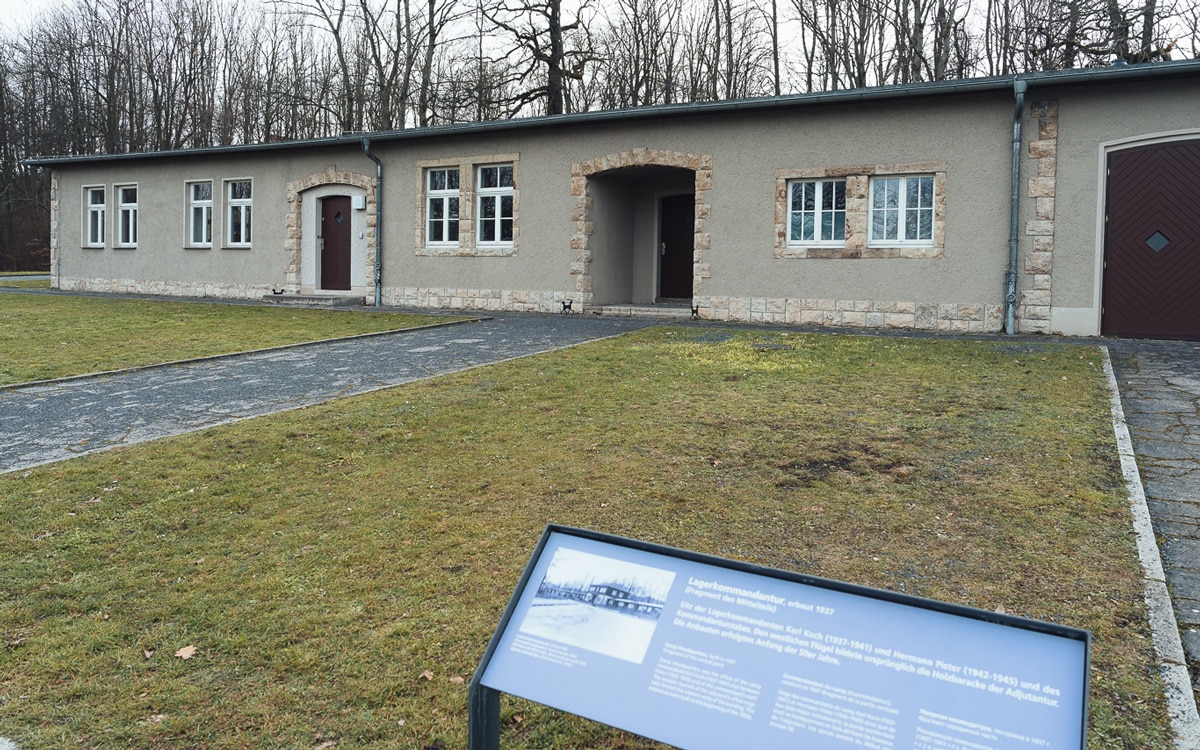
After the information desk at the Buchenwald Memorial, turn left and cross the former dog kennels and SS buildings to reach the 300-meter-long Caracho Trail.
On the way to the gate, I pass the place where the wooden barracks of the Political Department (branch of the Gestapo) once stood. Prisoners' personal details and deaths were registered here and extremely brutal interrogations were carried out. The camp commandant's office was located next to it. The original building was destroyed in an air raid in 1944, which is not entirely clear from the audio guide.
At the time of Special Camp No. 2, the Soviets had their own camp command built on almost the same site. It is the only surviving building from the time of Soviet Special Camp No. 2.
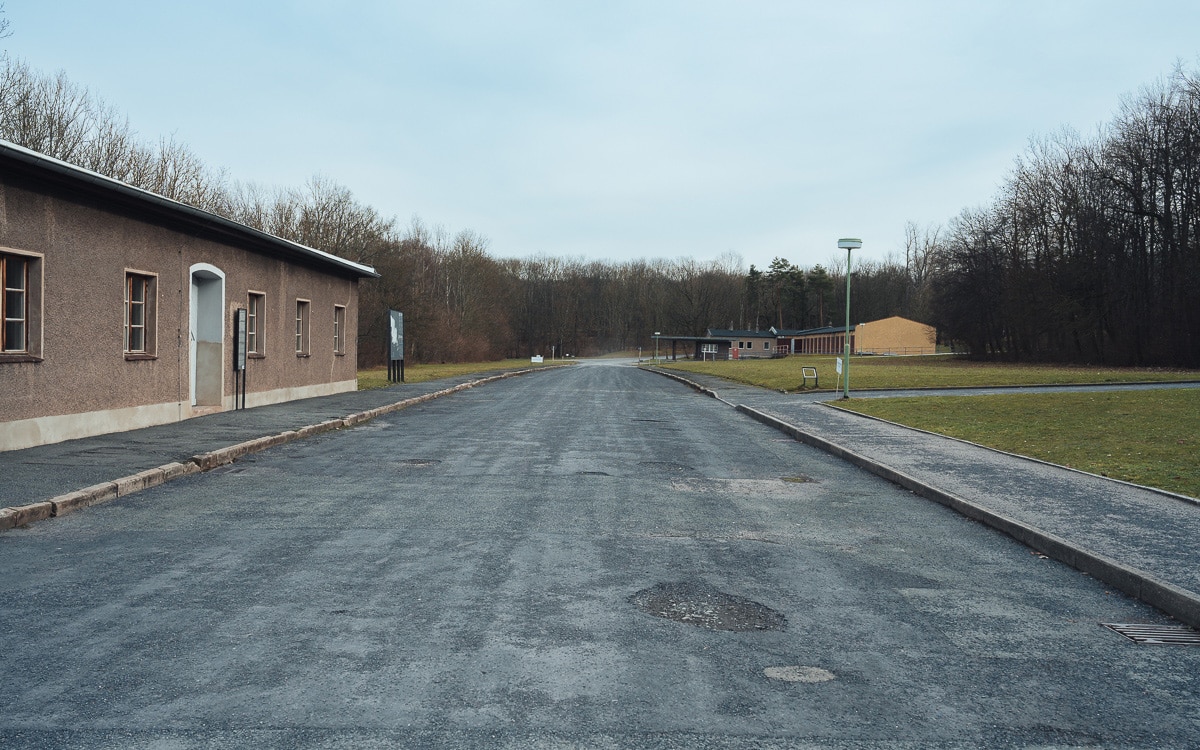
3. Gate building and camp gate
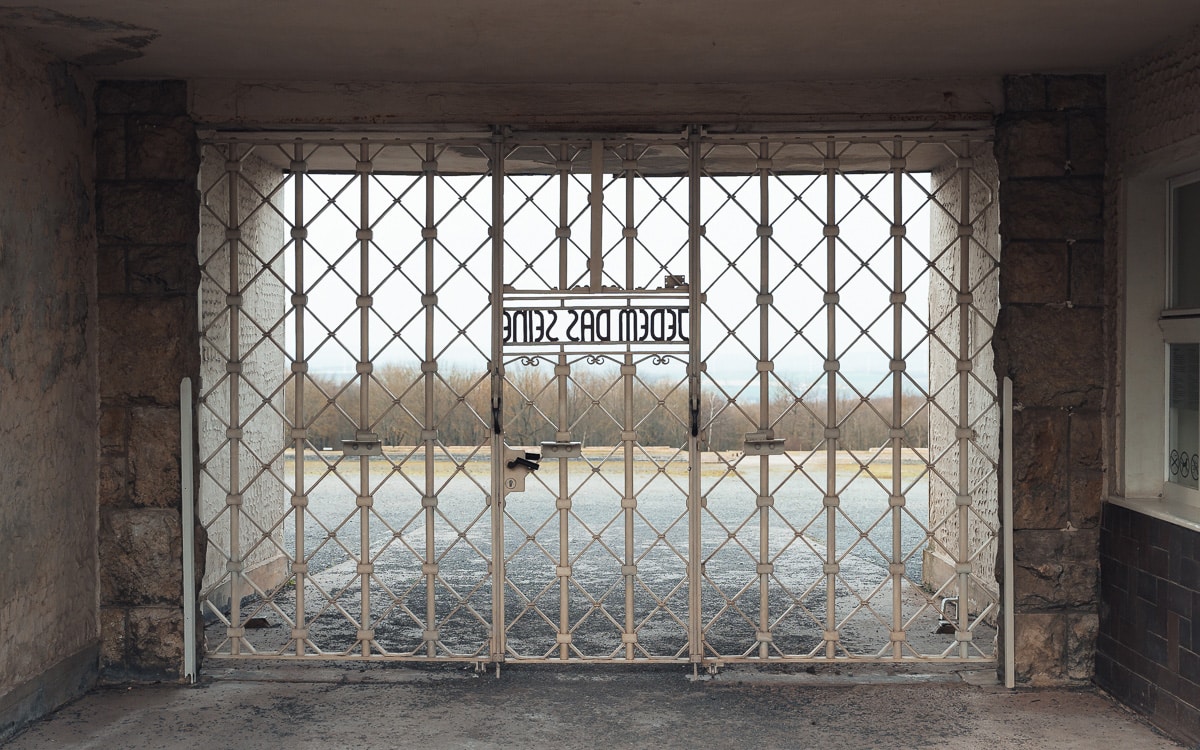
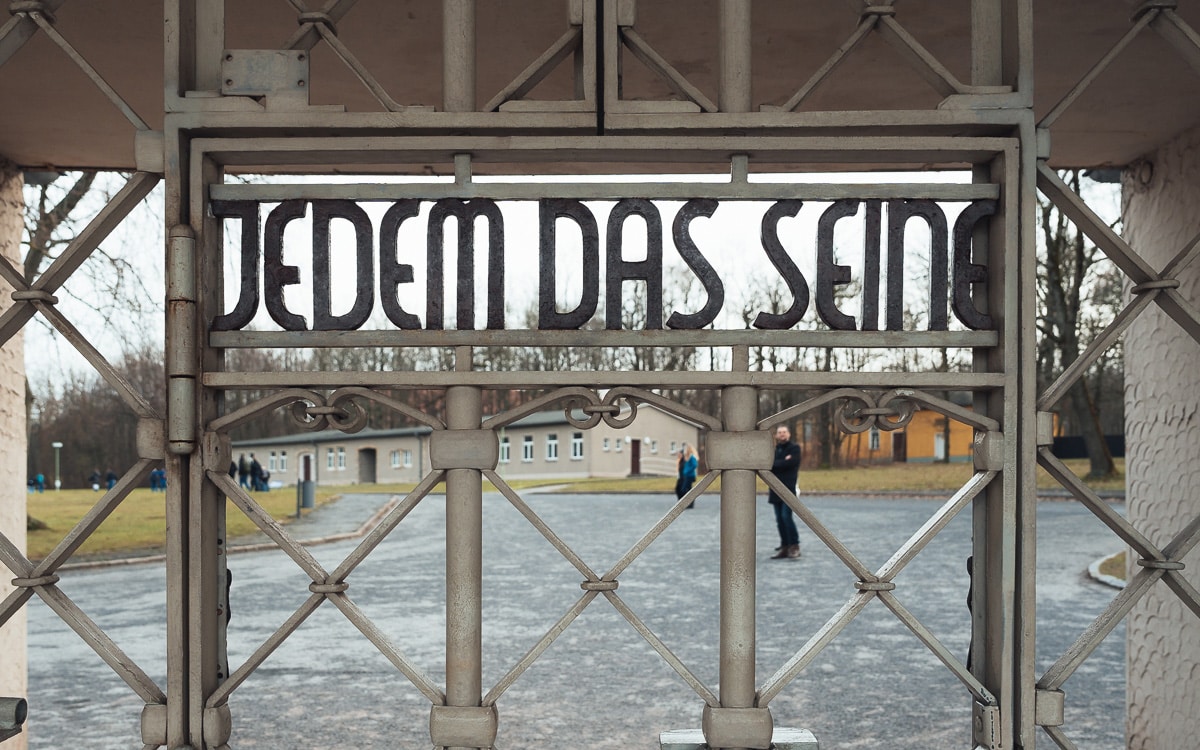
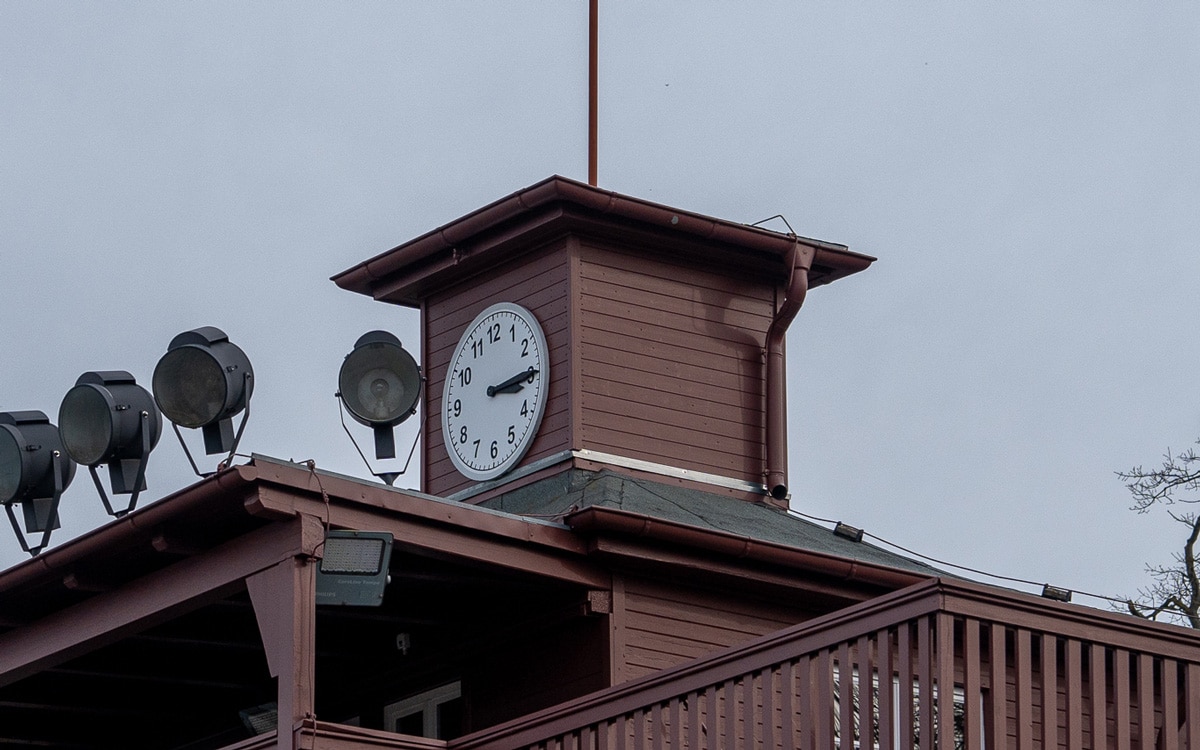
The Caracho path ends at the gate at the camp gate. On the door of the camp gate is written "To each his own", only legible from the inside, the clock is set to 3.15 p.m., the time of liberation on April 11, 1945. At this time, there were an estimated 21,000 people in the camp.
The camp gate is the only official access gate. Two other side gates at the watchtowers were only used for supply purposes.
The "bunker", the camp prison, was located in the side wings. Instead of the official sentences of up to a maximum of 21 days, many were tortured and interrogated here "until they confessed" and died after an agonizing ordeal.
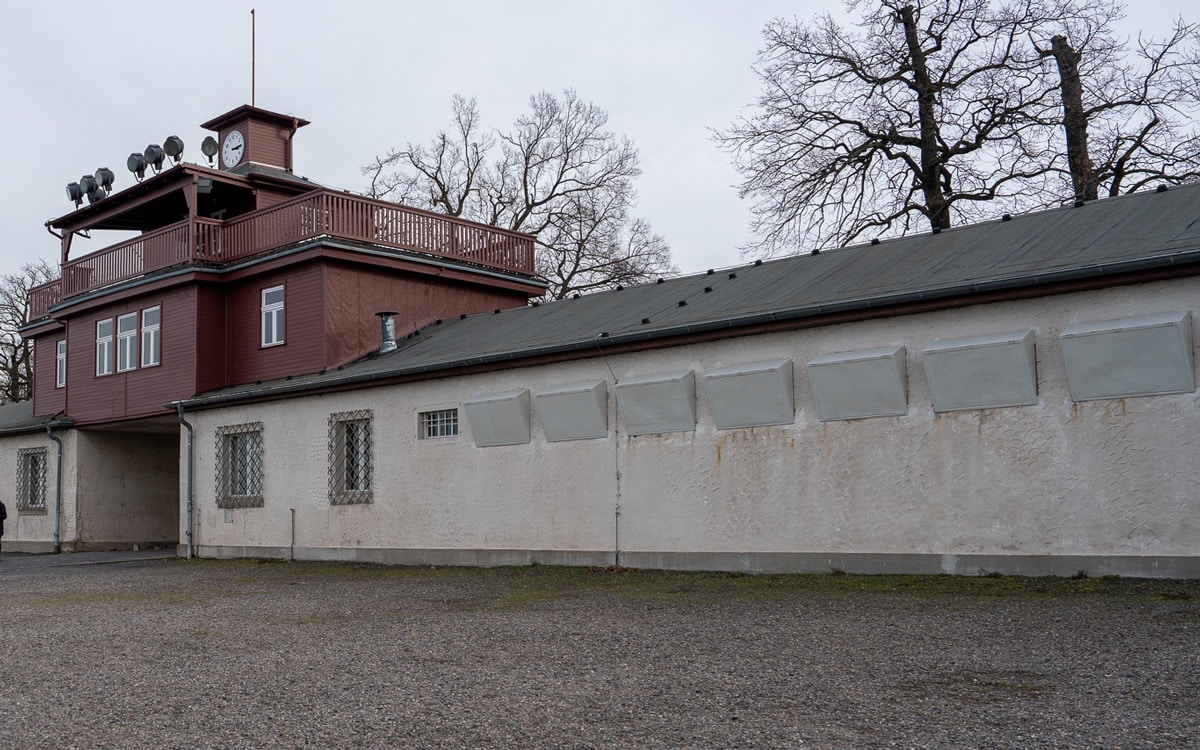
We pass through the so-called Jews' camp, through the quarantine camp and past the former prisoners' infirmary, where prisoners were given makeshift treatment by prisoners, but where the SS doctors also committed mass murder by lethal injection. A sign also draws attention to the location of a camp brothel. Female prisoners were once forced into prostitution here. I walk through the wooded area in silence and ask myself what actually drives people to commit such acts.
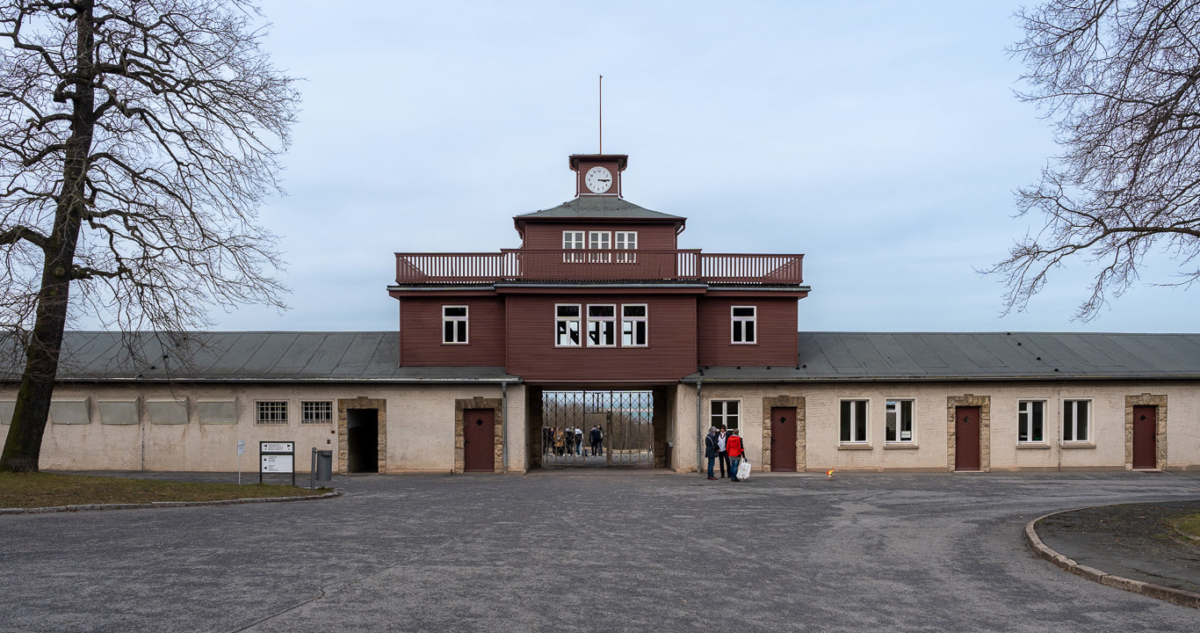
4. Roll call square, commemorative plaque and memorial stones
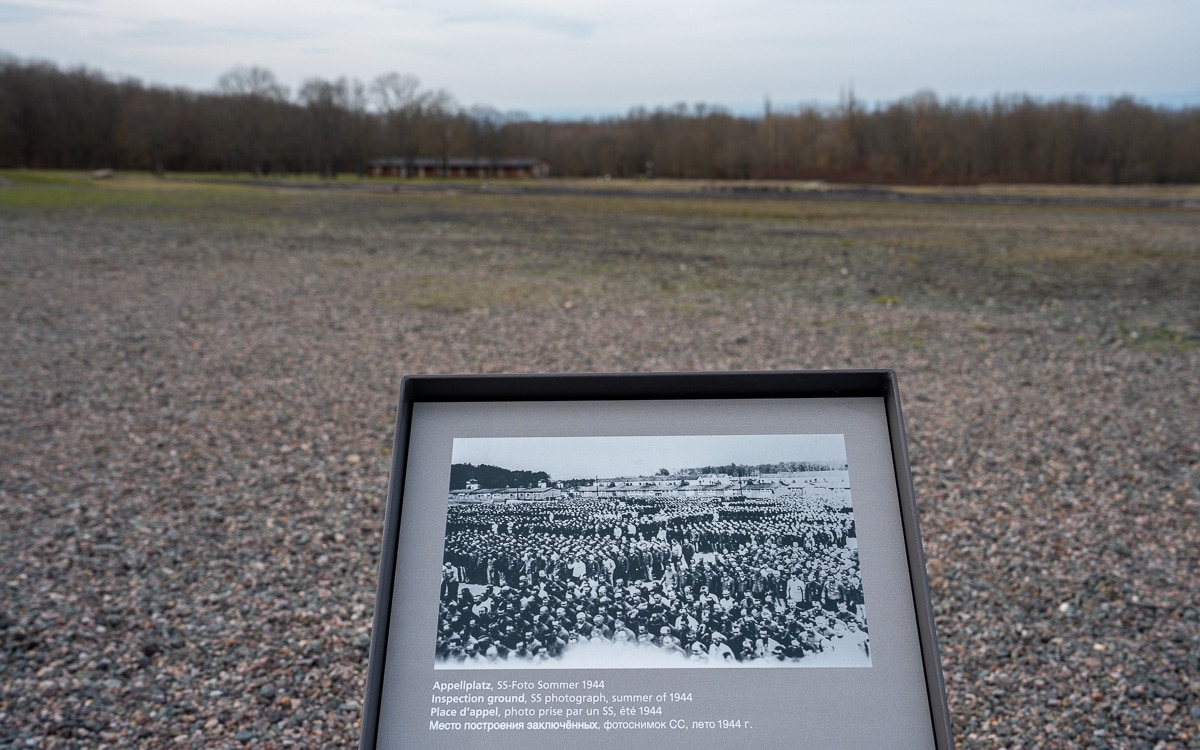
As soon as you enter the former camp, you find yourself on the roll call square, where the prisoners had to line up every day and evening for roll call. The barracks, in which the inmates were literally crammed in, were located around it. Memorial stones from 1955 remind us of this. Stones set into the extensive grounds tell you which block or barracks were located here.
The solidly built prisoners' kitchen, in which the prisoners were fed more poorly than well from 1941 onwards, still stands at the left end of the site. In the basement there was a makeshift chemical laboratory where soap was made, and the resistance squad secretly produced homemade hand grenades and incendiary devices.
Block 7, 8, the memorial for Sinti and Roma, the Jewish memorial and the small camp, I walk slowly and depressed. The silence is challenging to bear with all the impressions and information on site. At the bottom was the prisoner infirmary. Only a few dared to come here, as they didn't know whether they would be helped or killed immediately.

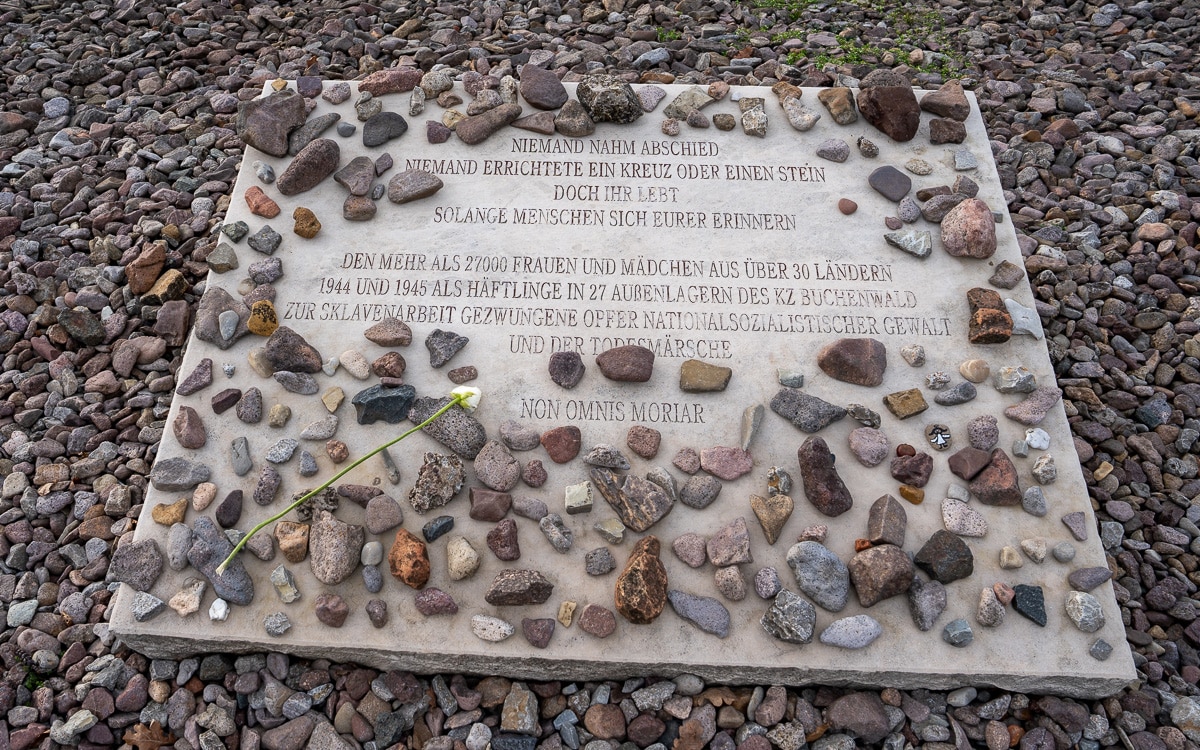

Today, the Jewish Memorial stands on the site of Block 22 honoring the 11,000 murdered Jews in Buchenwald and beyond 6 million people killed in the Holocaust. Barrack 22 was the so-called Jewish Block, in which Jews were imprisoned and killed solely because of their origin. They were the main target of the terror and were increasingly deported to the Bernburg and Sonnenstein killing centers and to Auschwitz. Only in this barrack were there still Jews doing forced labor in the quarry and menial work.
After the camps in the east were disbanded, more than 50,000 were taken west to Buchenwald and subcamps. In the end, only 3,000 Jews were liberated from Buchenwald. The others were sent on the death march shortly before liberation and killed.
Outside the camp, an SS guard path led around the entire area along the barbed wire fence.
5 Little Buchenwald camp
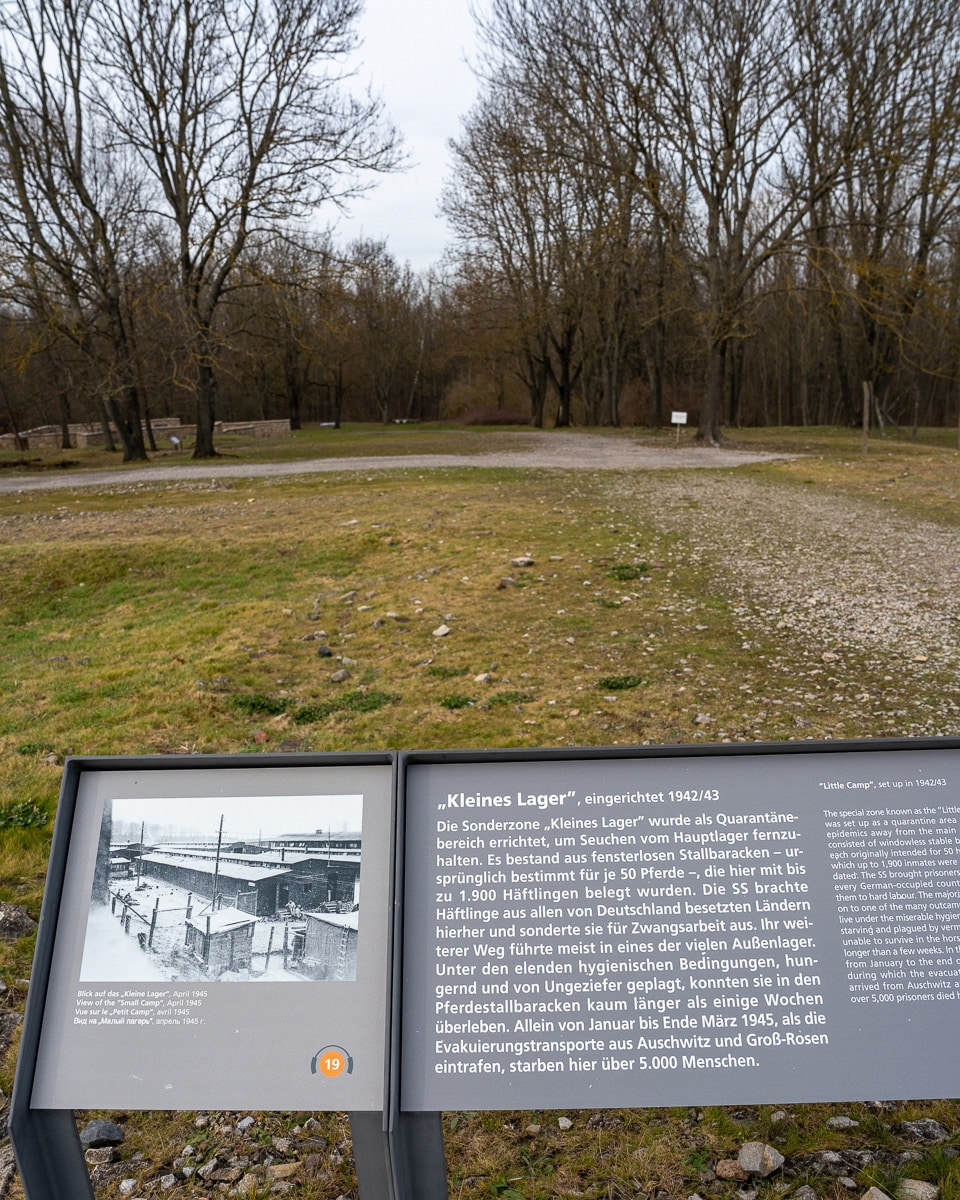
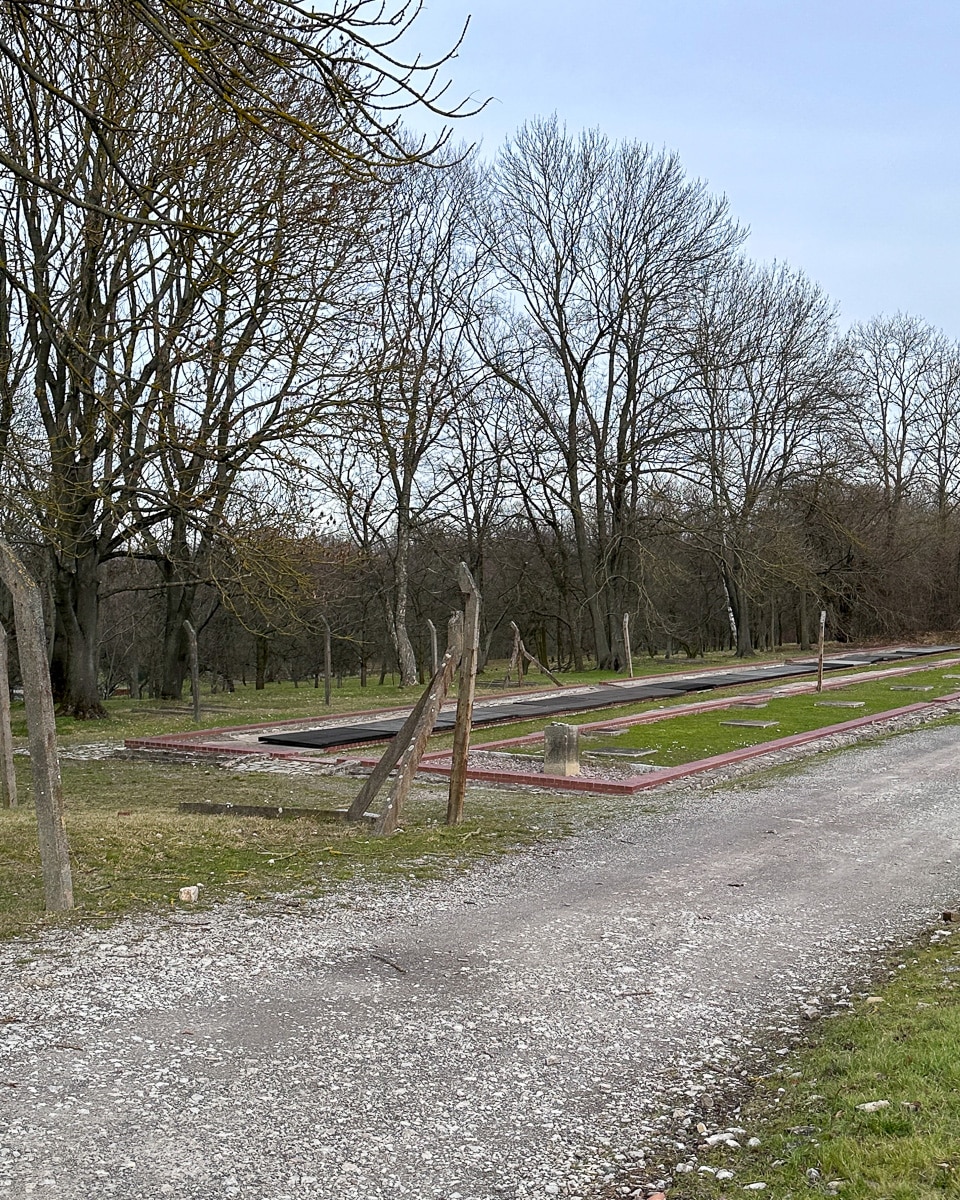
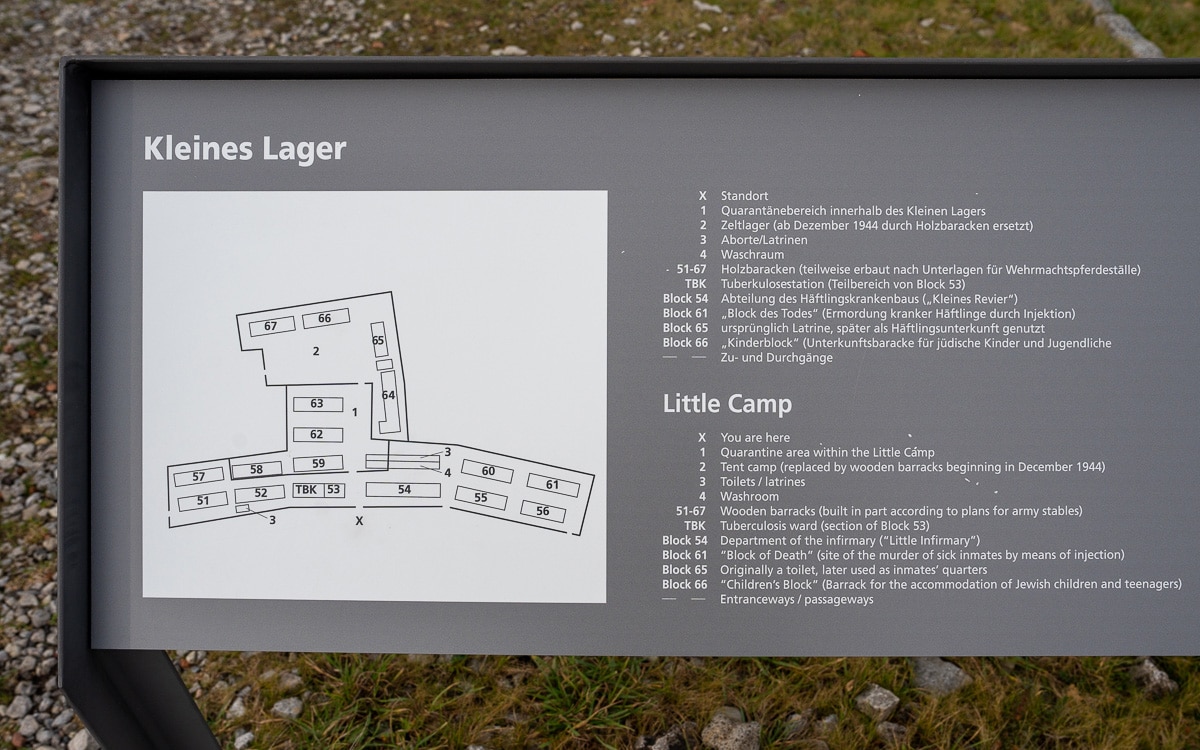
Only the remains of the latrine can still be explored on site today. In the small camp, the quarantine area, 12 windowless stables 40 meters long and 10 meters wide were built within a very short space of time. The stables, originally intended for 50 horses each, were quickly used for people. These had to accommodate 1000 to 2000 people on, platform-like shelves made of 4 layers.
Catastrophic conditions prevailed in the small camp due to the cramped conditions and poor hygiene. Many prisoners died of disease, hunger and exhaustion. There was also hardly any medical care available. It was the worst "slum" of the concentration camp. After a short stay, the inmates were sent to subcamps - if they survived the misery.
Jews in particular were crammed together here shortly before liberation, after the camps to the east, such as Auschwitz, were evacuated. According to the guide, more than 5000 people died here within 2–3 months before the liberation.
6. Block 50: typhus production and laboratory
The block was provided with a separate entrance and fence in 1943. Medical experiments had already been carried out on humans before this (at the other end of Block 46). This building was also used from 1943. A laboratory was also set up here to evaluate the medical experiments. This building was called the "place of death".
These experiments were carried out by Dr. Erwin Ding-Schuler. He investigated the effects of vaccines (yellow fever vaccines and a gas gangrene serum) and medication on diseases such as typhus and tuberculosis, as well as on wounds and injuries. The prisoners were deliberately infected, and the experiments often led to serious damage to health and even death. Later, the production of typhus serum for the Waffen-SS also began.
These experiments were discovered after the camp was liberated by the Allies and Ding-Schuler was later sentenced for his crimes. Most of the prisoners selected for these experiments were Soviet prisoners of war.
To this day, it has not been possible to determine the exact number of victims. It is only known that over 1000 prisoners were experimented on.
7. Special camp for Soviet prisoners of war (1945 -1950)
The museum provides information about the development of the Soviet special camp.
After the end of the Second World War, a total of 10 camps and three prisons were used to intern Germans in the Soviet occupation zone. One of these camps was the so-called Special Camp No. 2 Buchenwald, which was used by the Soviet security service from August 1945. Mainly local functionaries of the NSDAP, but also young people and denounced persons, were detained here without legal proceedings. The prisoners were completely isolated and all contact with the outside world was prevented.
A total of around 28,000 people were interned in this camp, of whom over 7,000 died of starvation, especially in the winter of 1946/47. The camp was dissolved in February 1950, shortly after the founding of the GDR.
8. Chamber building: museum with permanent exhibition on the history of Buchenwald Concentration Camp
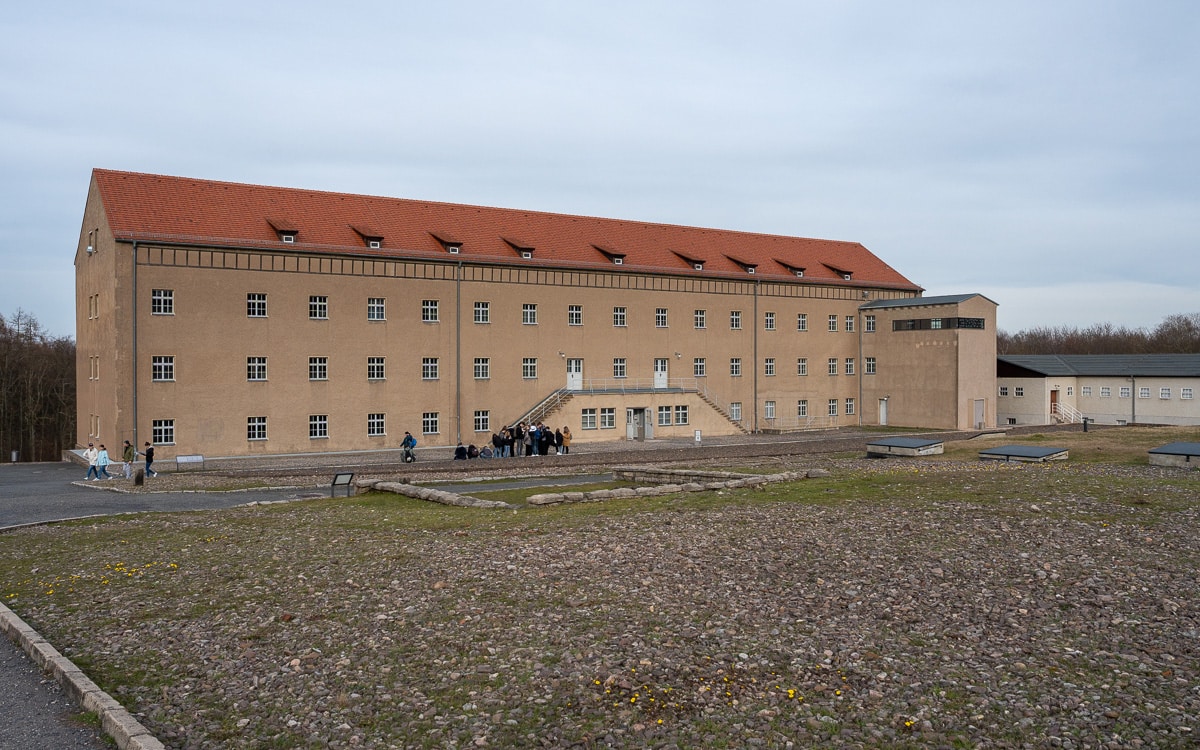
From 1939, what was once the largest building in the camp served as a clothing store and storage area for prisoners' belongings. All new arrivals had to leave behind everything they were carrying on arrival. Here they were given the striped uniform clothing, number and angle markings made of cloth.
Since 1985, the museum has housed a permanent exhibition on the history of Buchenwald Concentration Camp.
The exhibition shows both the horrors of the Buchenwald concentration camp and the prisoners' struggles for freedom and dignity. Here are some highlights of the permanent exhibition that you should definitely plan time for. So that you don't have to read all the panels, you can also navigate through the exhibition with the audio guide on your cell phone.
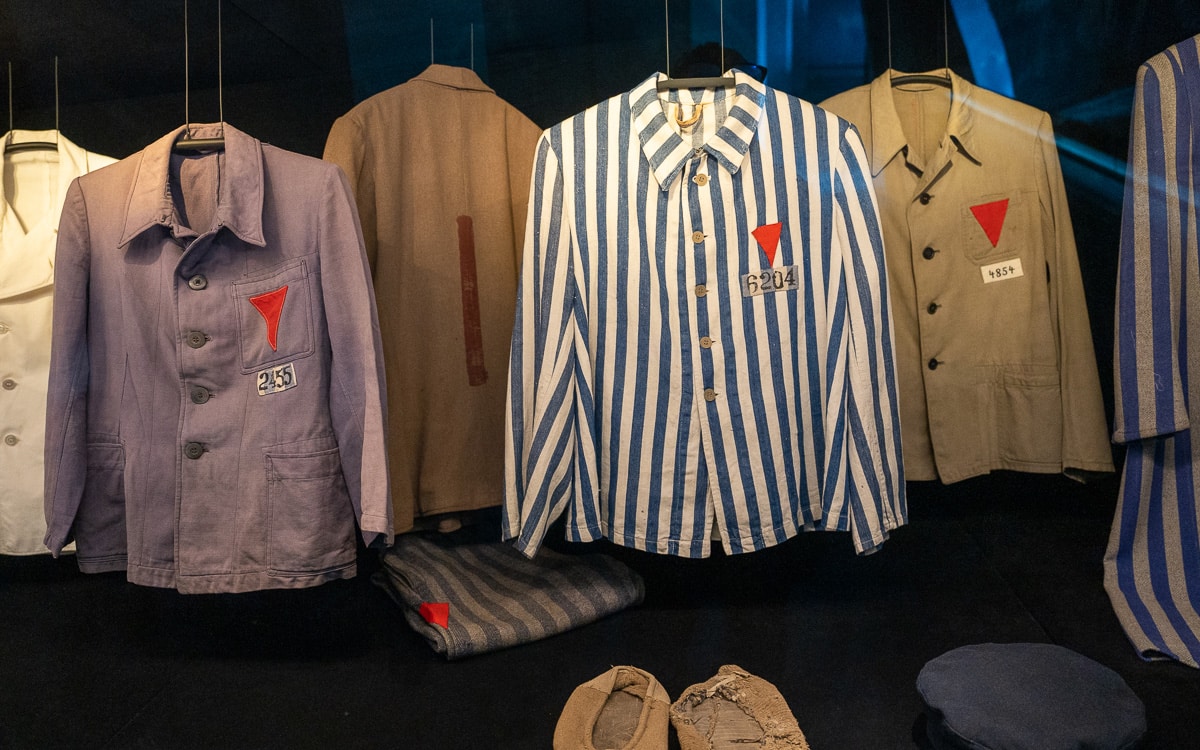
The exhibition begins on the first floor with an introduction to the political and social circumstances that led to the creation of the Buchenwald concentration camp. Some central themes of the exhibition are the deportation and arrival of the inmates, the violence, and oppression in the camp, the work of the inmates and the medical experiments that were carried out on them.
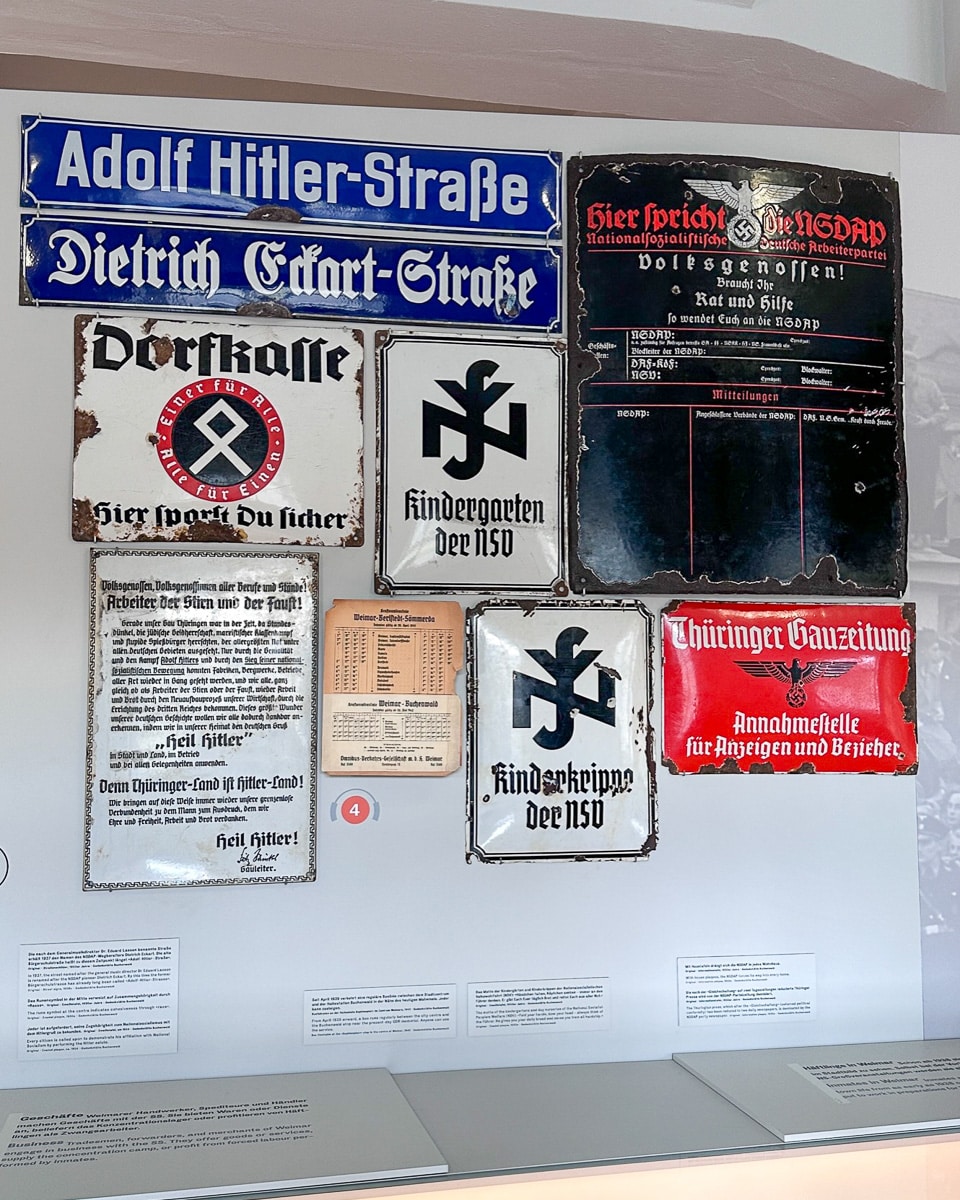
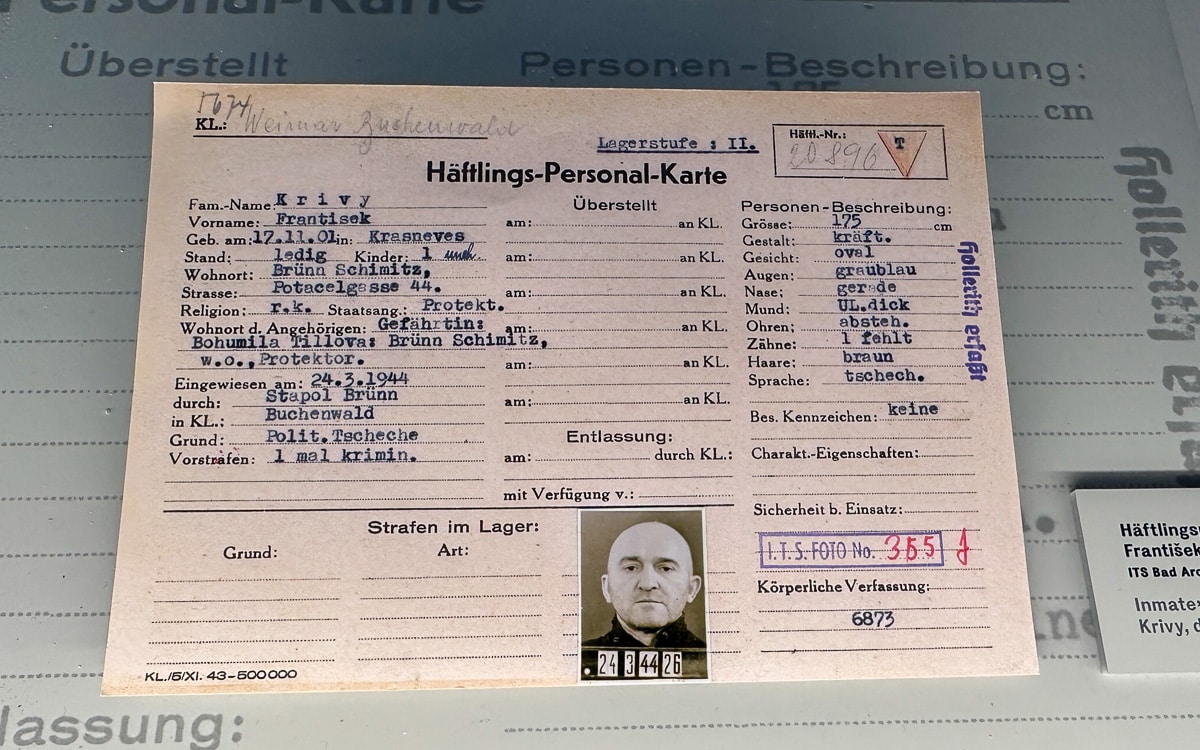
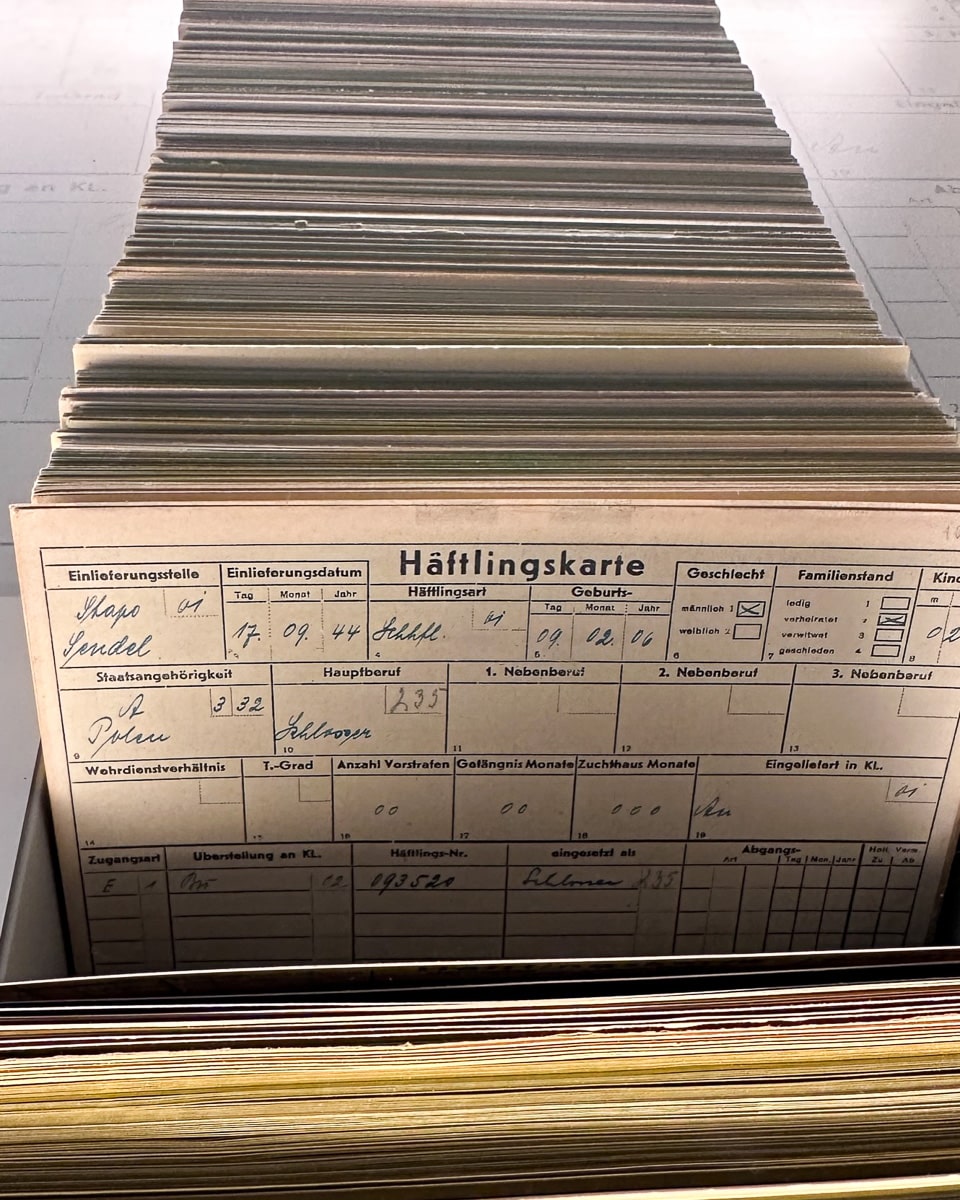

The museum contains many personal stories of survivors and shows how they developed survival techniques against all odds. Another important theme of the permanent exhibition is the prisoners' resistance against the Nazi regime, including the organization of uprisings and sabotage actions.
The exhibition also houses a large collection of artifacts and documents, including clothing, prisoner files and personal belongings of the prisoners, which you can view.
All in all, the museum in the former Buchenwald concentration camp is an impressive and moving exhibition that enables you to understand the tragic history of the camp even better.
Tickets must be reserved in advance here (free of charge)
9. Disinfection building with art exhibition
Right next to it is the disinfection building, which houses an art exhibition and changing special exhibitions.
As more and more prisoners arrived from Europe in 1942, this building was erected. Here, everyone had to take off their clothes, hand over their personal belongings, and were shaved and disinfected. The prisoners were then re-clothed in the adjoining chamber building before being transferred to the barracks.
Today, the disinfection rooms house the memorial's art exhibition as well as changing special exhibitions.
10. Crematorium
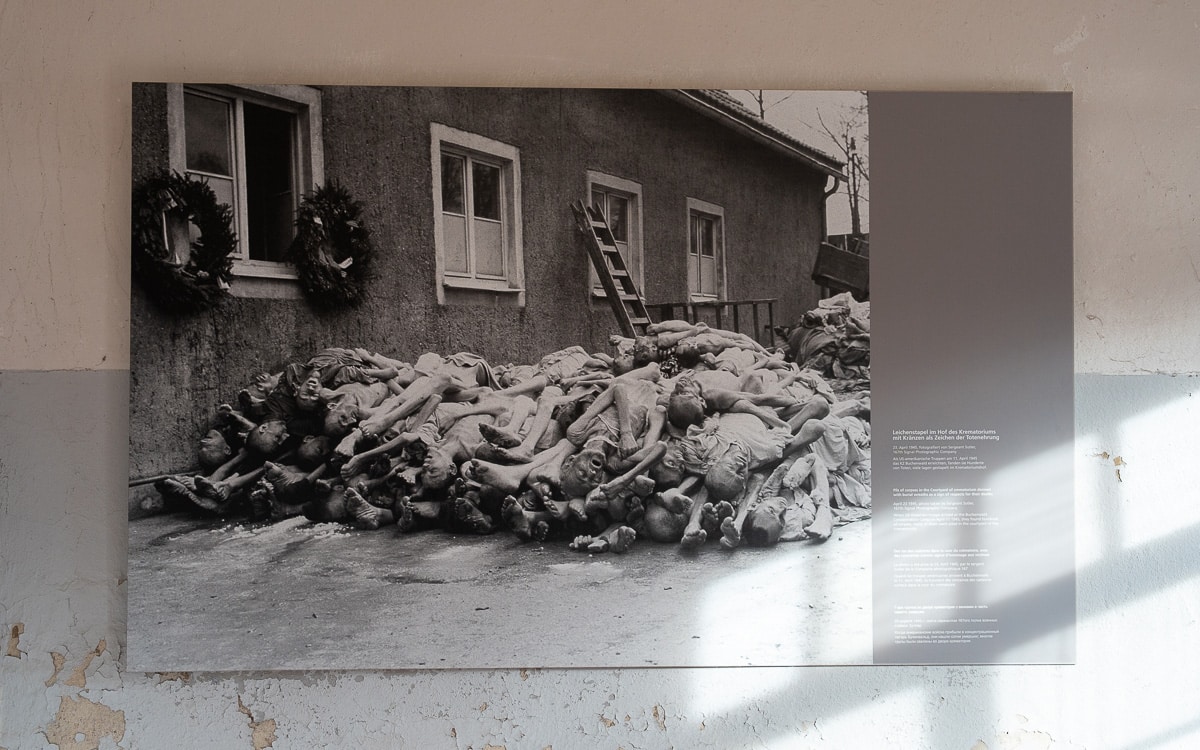
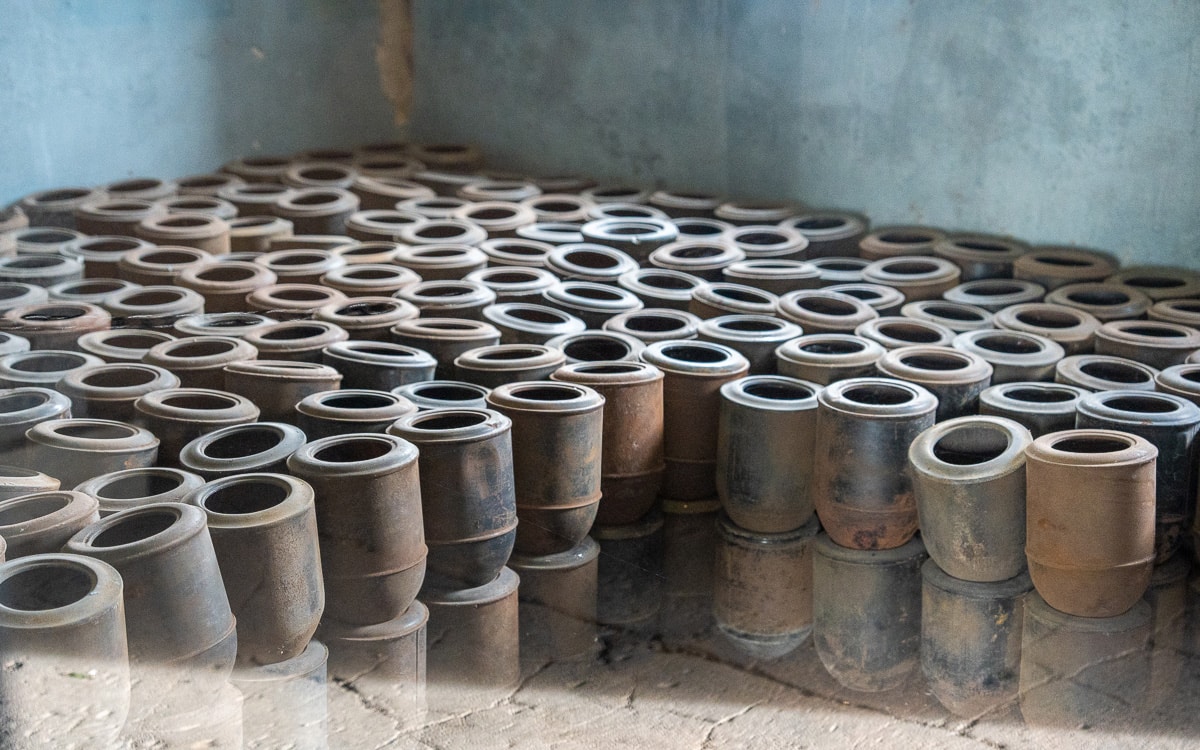
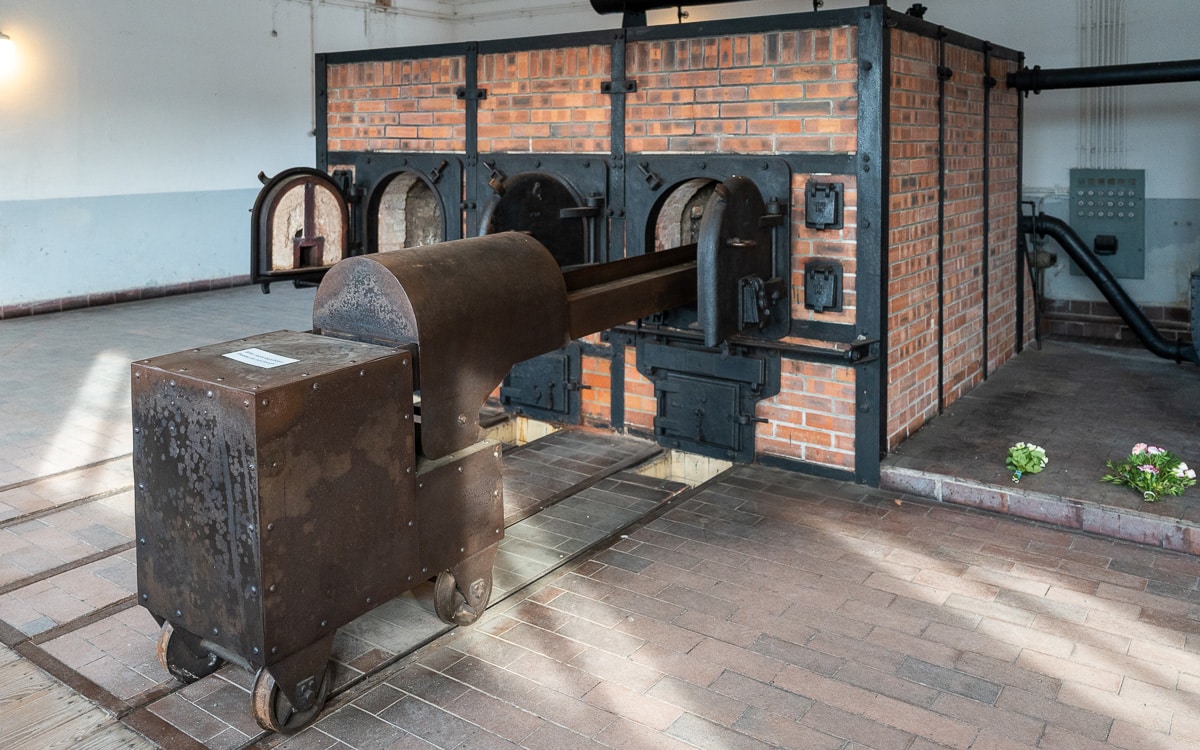
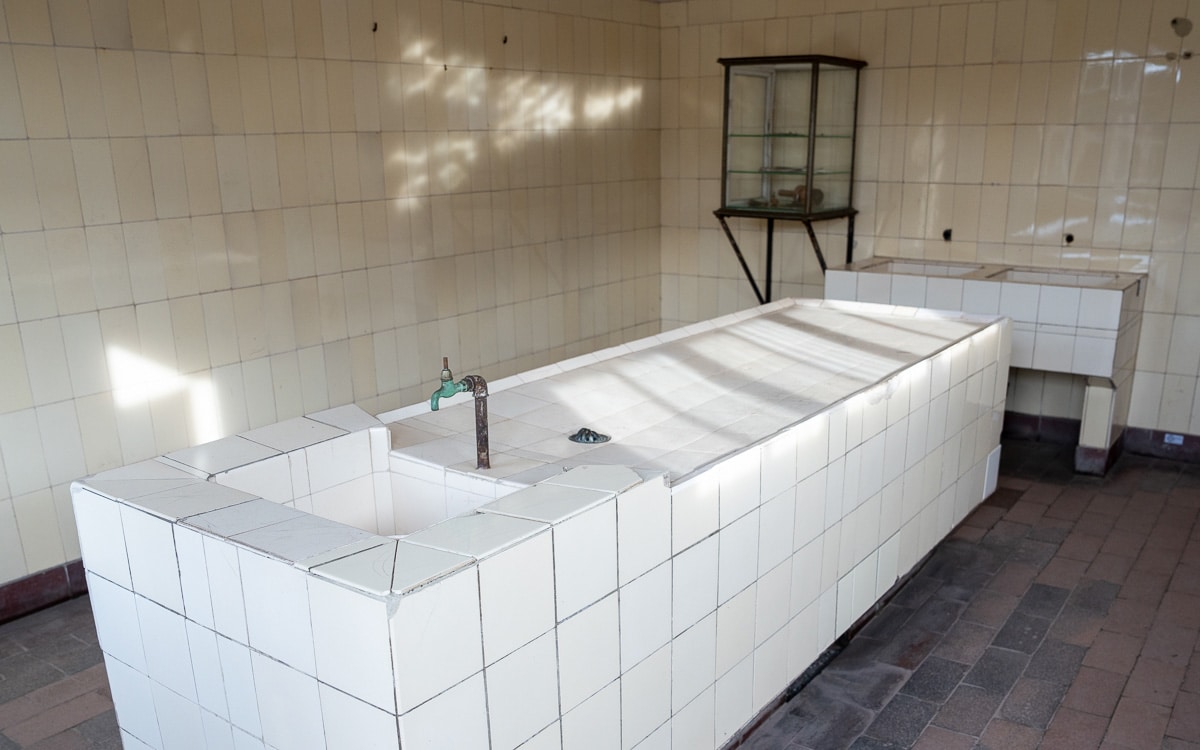
Due to the increasing number of deaths in the Buchenwald concentration camp, the SS decided to build a crematorium in 1940 and to expand it in 1942. The Topf & Söhne company from Erfurt was responsible for developing and supplying the incineration ovens. Around 1,100 people were killed by hanging in the building's morgue cellar.
What many people don't know: There was no gas chamber in Buchenwald.
Between autumn 1941 and 1943/44, the SS murdered over 8,000 Soviet prisoners of war by shooting them in the neck in a massive, 55-metre-long horse stable next to the camp commandant's riding hall. The execution facility consisted of several rooms in which the victims were made to believe that they were undergoing a medical examination. The bodies were then transported in galvanized containers from the east side of the building to the crematorium.
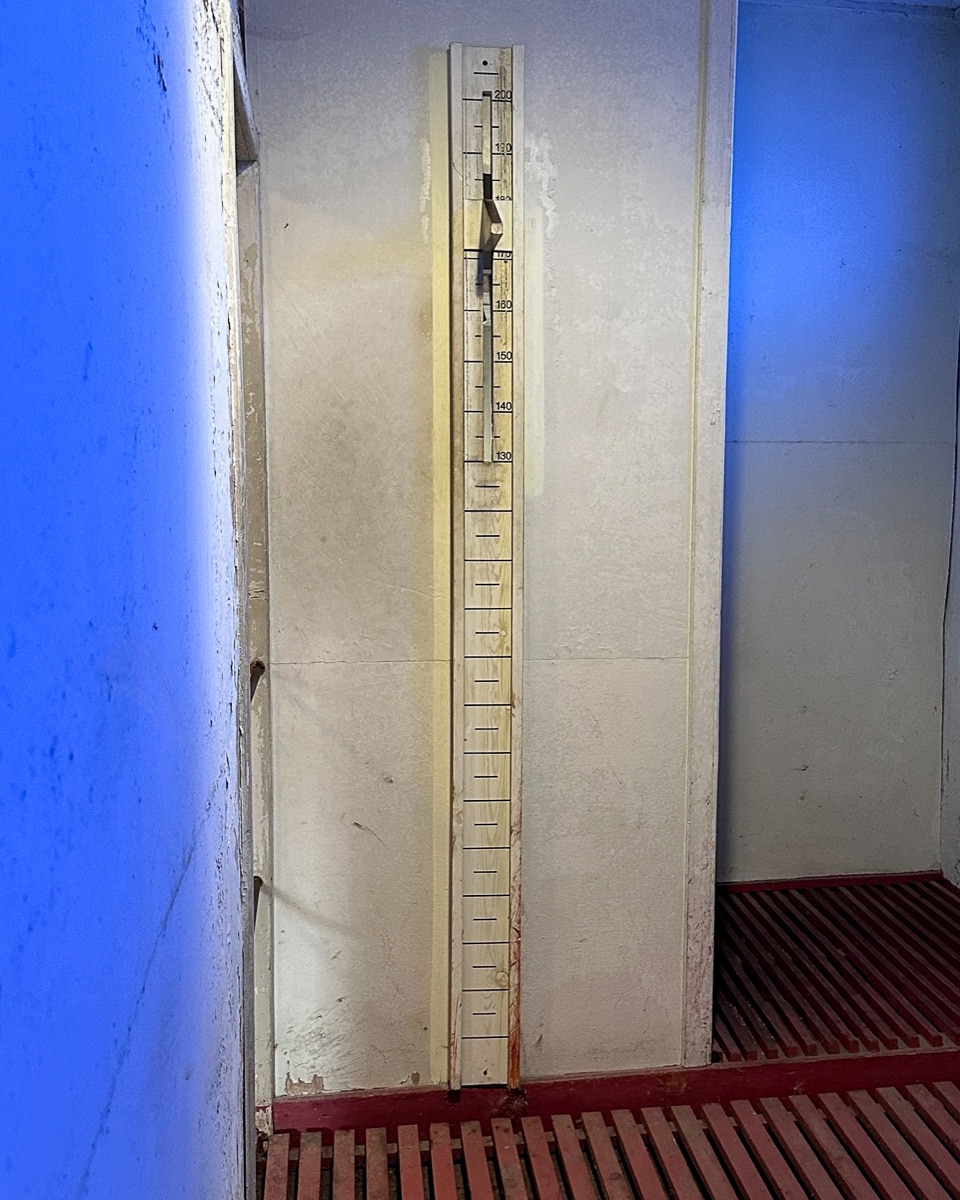
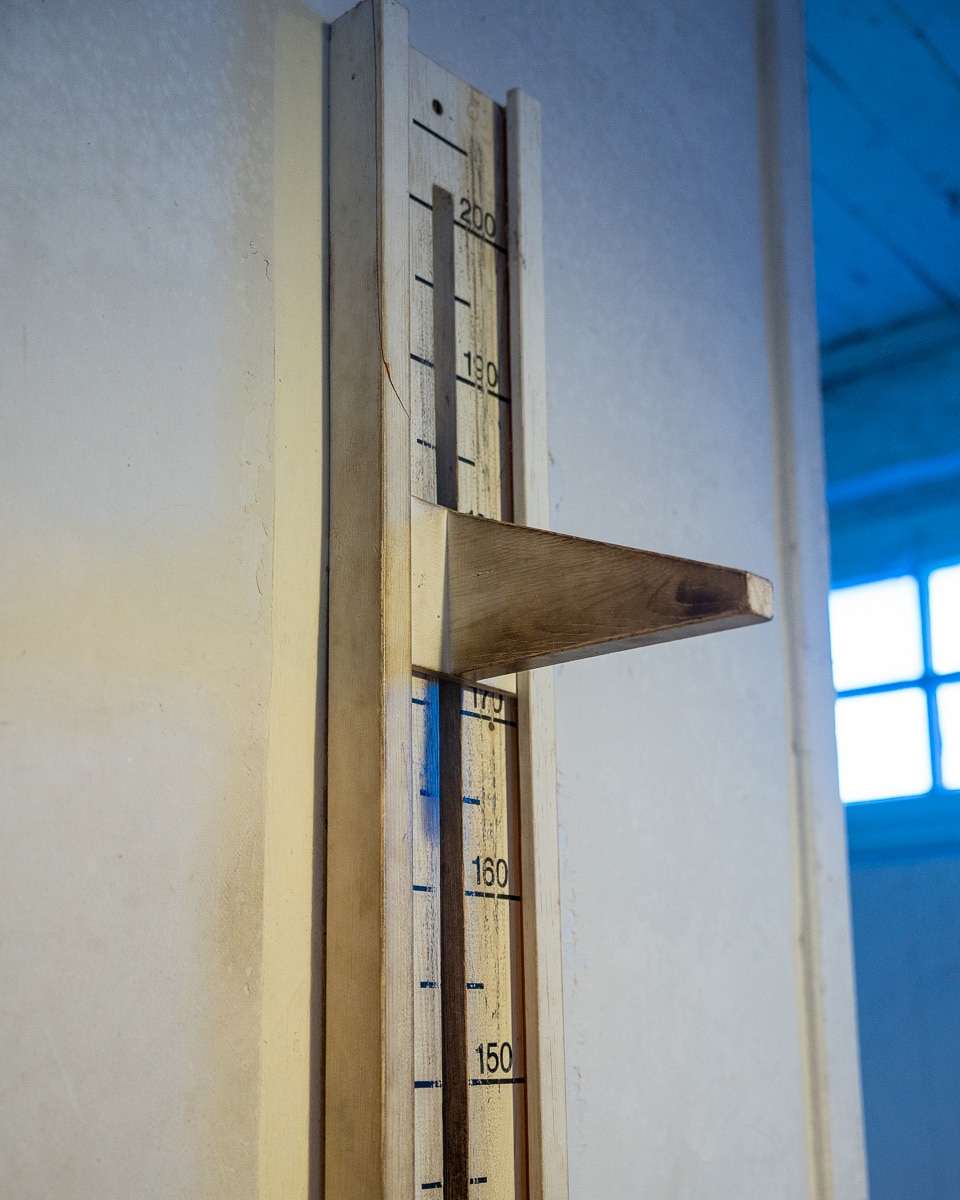
You can see such a lorry, as well as a replica of the neck-shooting device, in the annex at the back of the crematorium. It was made from a measuring stick on the wall, which was given a slit at neck height so that the victims from the room next door could be shot in the back of the neck.
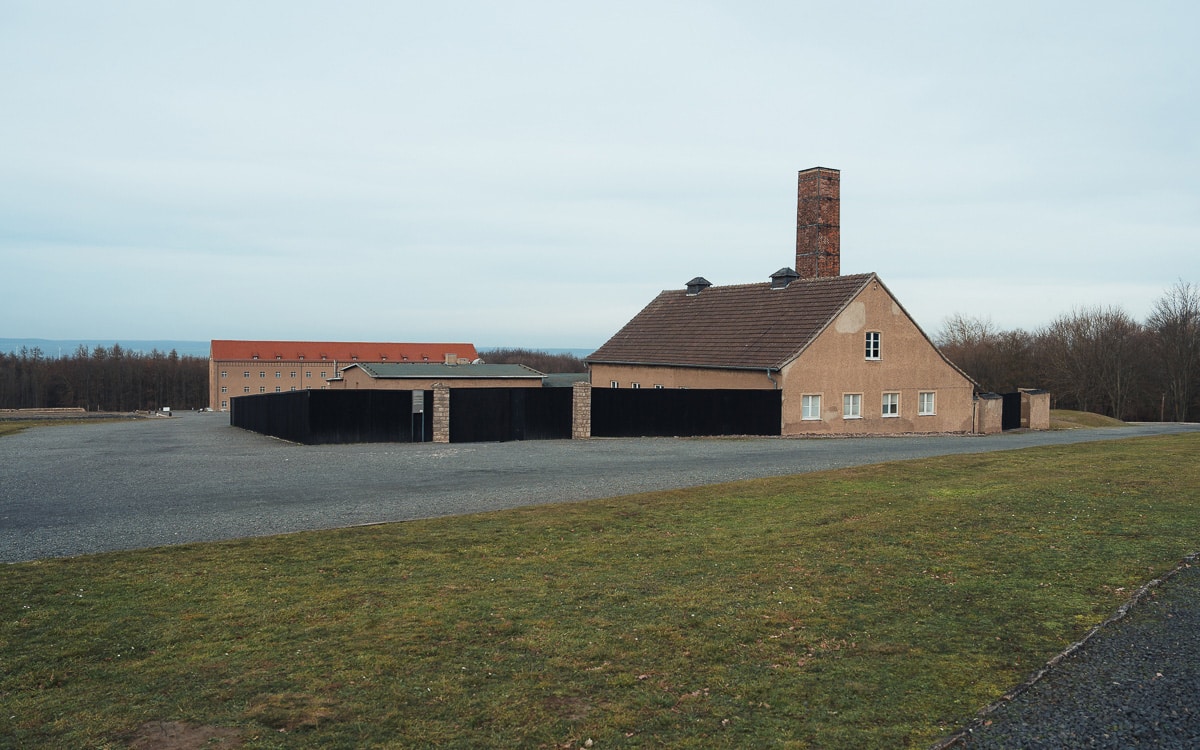
11. SS Zoo
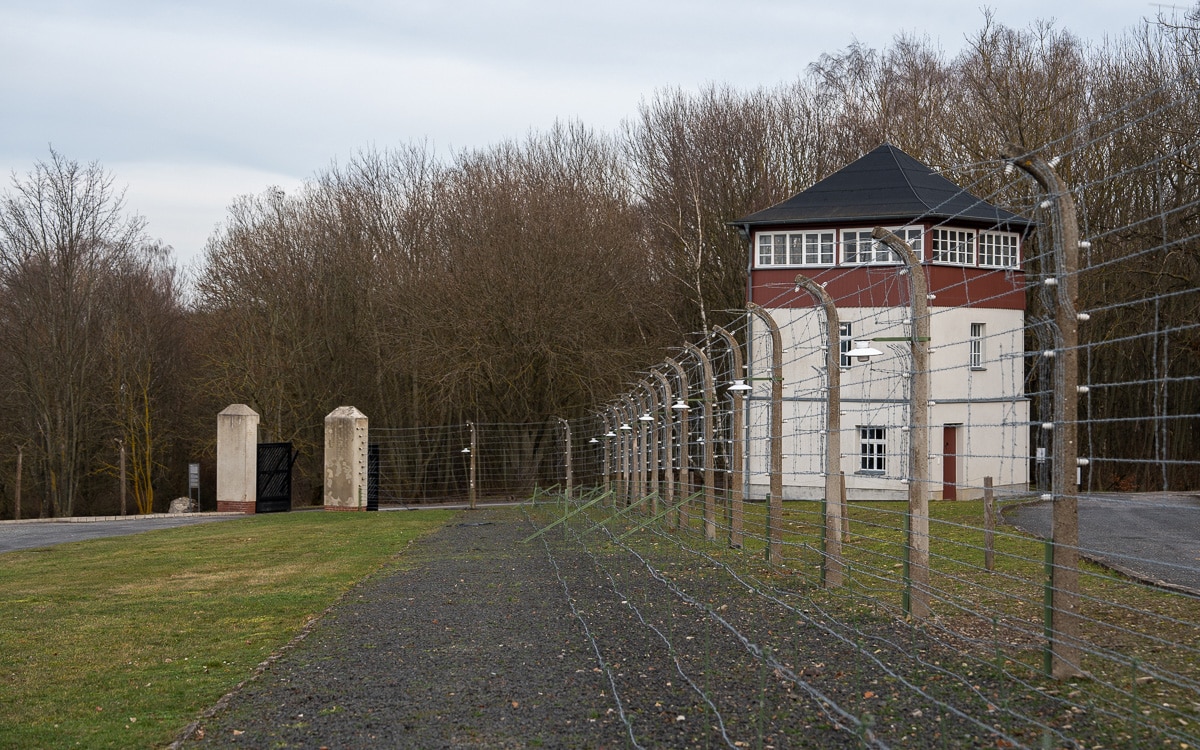
In 1938, Karl Koch had a recreational area with a bear cage built, of which only relics remain. The "SS Zoo" was financed by extorted donations from the inmates. The highlight was to be four brown bears, which were kept in a kennel between a barbed wire fence and a guard path.
The zoo was intended to provide entertainment for the SS men. Koch himself took a trip to the zoo with his children. How sick is that? The bears were probably fed with the meat that should have gone to the prisoners. The animals fared better than the camp inmates.
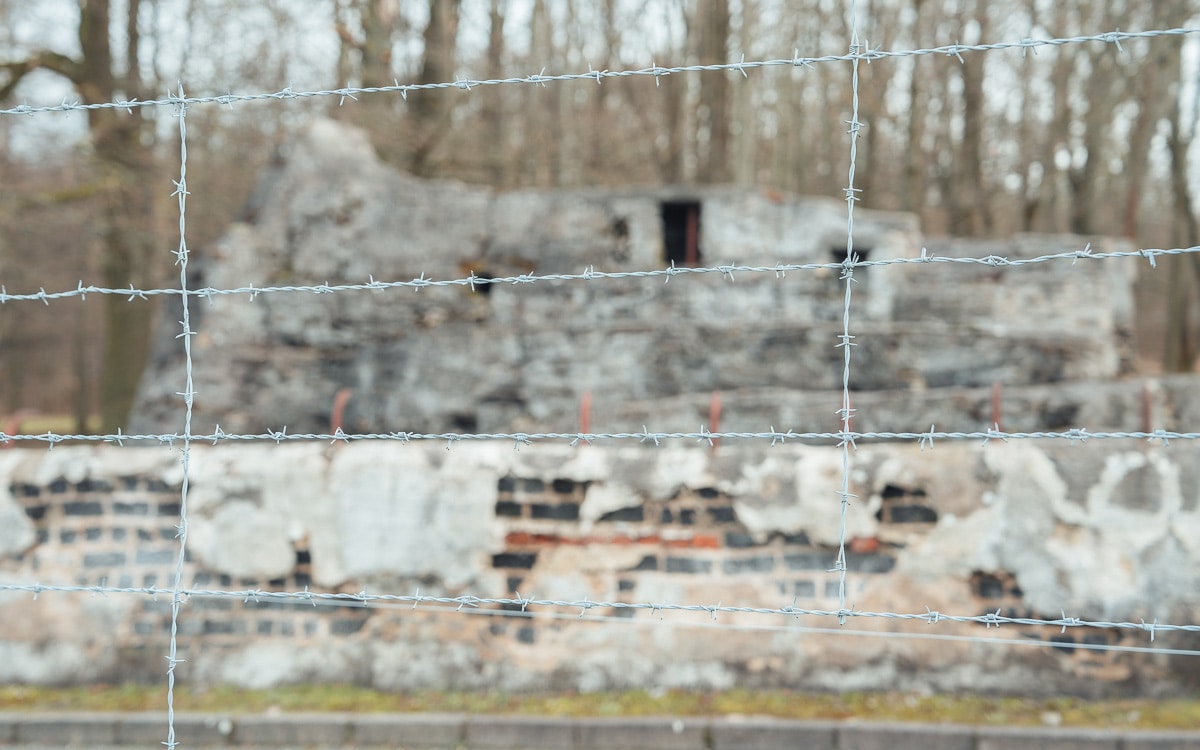
12. Buchenwald Railway and Gustloff Plant II
Construction work on the Buchenwald Railway began in March 1943 under the direction of the SS. More than 1,400 prisoners, including children, were forced to work on the line under appalling conditions. According to the guide, one in three prisoners died due to hunger, exhaustion, and mistreatment during the construction of Gustloff-Werke I and II and the railroad. The 10 km long line to Weimar was to be completed in 100 days. After the railroad line was completed, the prisoners were also used to operate the railroad.
The Buchenwald Railway was also part of the so-called "death march", during which thousands of prisoners were forced to walk for several days through Thuringia and Saxony in April 1945, as the concentration camp had to be evacuated due to the advancing Allies. Many prisoners died during the death march or were murdered by the SS guards.
Today, parts of the Buchenwaldbahn line have been preserved as a historical monument and can be visited.
Buchenwald memorial with bell tower
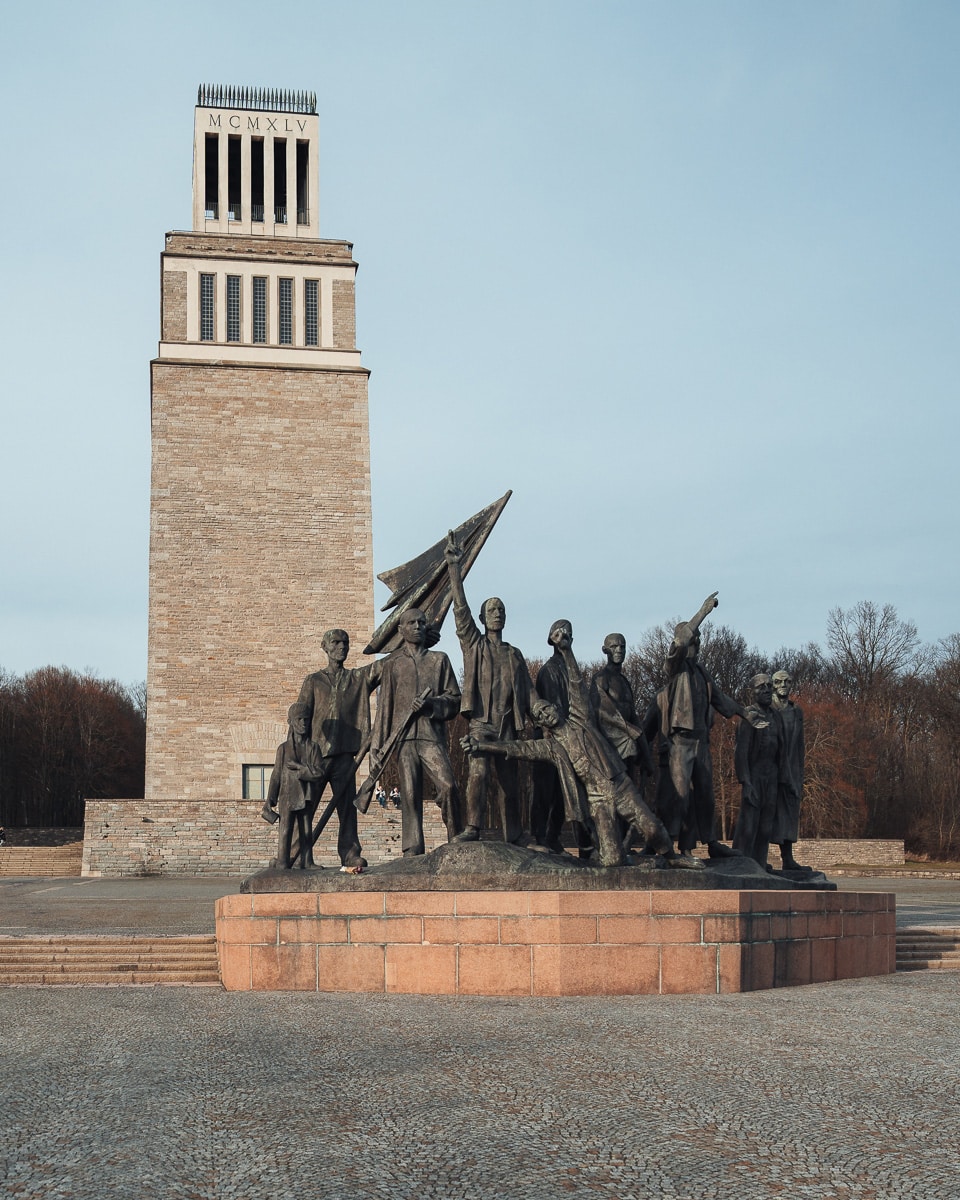
The Buchenwald Memorial, which is located on the south side of the Ettersberg near Weimar and can even be seen from Erfurt thanks to its bell tower, was erected as a memorial to the victims of the concentration camp, which was in operation from 1937 to 1945.
You start your tour at the parking lot with the descent to the mass graves. Along the Ettersberg and up to the ceremonial square and the 50-metre-high bell tower, which was built in 1958 in the center of the site. The bell weighs 11 tons and is rung every year on 27 January, the day the concentration camp was liberated. I don't understand why it was ringing during my visit, if that's the case (unfortunately, I was traveling alone and couldn't ask anyone).
The site is located on the site of the former Bismarck Tower, which was blown up in May 1949 for the construction of the memorial. The mass graves consist of three funnel-shaped sinkholes in which the SS had the bodies of murdered prisoners buried in 1945. Urns containing human ashes were stored in the tower itself.
Later, a cemetery was created for over 400 prisoners of the camp who died after liberation and for the ashes from over 1286 urns. In the first years after the war, this area was redesigned as a grove of honor for the unknown dead of the concentration camp.
An equally depressing, but at the same time beautifully designed place with a great view down to Weimar and the Thuringian countryside.
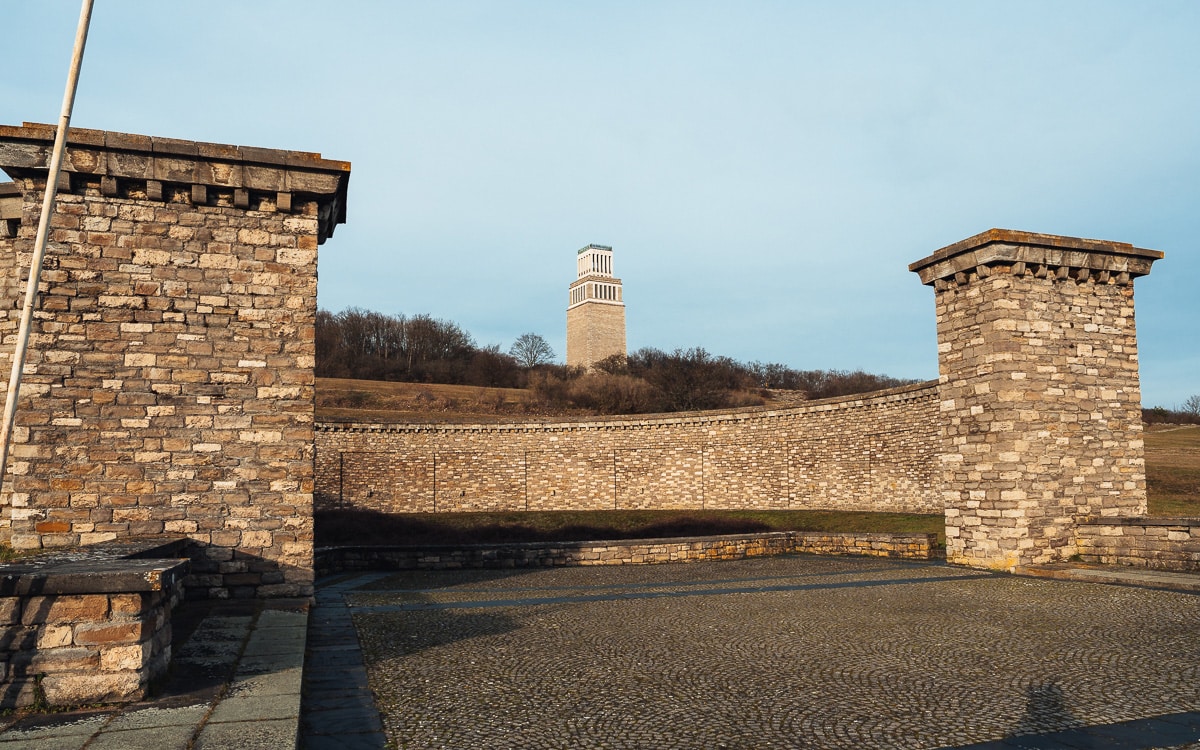

Buchenwald Concentration Camp Guided Tour
Visiting the memorial is free of charge. However, you can book a guided tour. A tour lasts approximately 2 hours and takes place twice or four times from Tuesday to Sunday, depending on the time of year. These tours are conducted by the staff of the Buchenwald Memorials Foundation.
- Price: Tickets cost 7 euros
- Children aged 15 and over can take part
- You should buy your ticket at the visitor center at least 15 minutes before the tour starts
Information on visiting the Buchenwald Memorial
There are a few things you should know if you want to visit the Buchenwald Memorial at the former camp.
- Dogs are prohibited
- Children should only visit certain places such as the crematorium or museum from the age of 12. Participation in guided tours is only permitted from the age of 15.
- Download the app on your cell phone to use the audio guide. It's really well done, even if a guided tour is even better.
- Please respect the rules: appropriate clothing, no eating and drinking and above all: silence, no shouting.
Directions and arrival
The distance from Weimar to Buchenwald is 10 km and about 15 minutes by car. The journey is via the infamous Blutstraße, which leads to Buchenwald.
By bus from Weimar
From Weimar, you can get to Buchenwald by bus from Weimar main station in 20 minutes. The buses run regularly to the visitor information center and memorial site, as well as stops at the obelisk, Buchenwald Railway Memorial Trail and bell tower. You can view the current timetable for city bus route 6 on the Weimar public utilities' website, or simply use Google Maps.
With your car
If, like me, you arrive by car or camper van, you can park in a large parking lot at the entrance. The walk to the gate of the concentration camp then takes about 10 minutes.
- Address for navigation: Buchenwald Memorial, 99427 Weimar, Germany
- There are two charging stations in the parking lot
Accessibility
The visitor information desk, all exhibition buildings, the museum café, the archive, and the library are barrier-free and have ramps, elevators and wheelchair-accessible toilets.
Due to the preservation of historical monuments, some buildings, and paths in the former prisoners' camp, such as the camp prison ("bunker"), the crematorium, the prisoners' canteen and the disinfection building (now an art exhibition), are only partially accessible. Information is available at the visitor information desk.
Where to stay
- There is a youth hostel right at the entrance to the memorial (go to the website here)
- You can find a camper van site in Weimar and Erfurt.
- There are several hotels in Weimar and Erfurt, which is also only 30 minutes away.
Names you encounter in Buchenwald
Karl Koch
Koch was considered one of the worst concentration camp commanders. He was camp commandant from 1937 to 1941. He was shot by his men in 1945 for corruption.
Ilse Koch, the witch of Buchenwald
The wife of the former commandant, Ilse Koch, was also known as the "Witch of Buchenwald". You should definitely watch this movie if you want to find out more about this cruel woman.
Watch "The Witch of Buchenwald" movie on YouTube here.
Hermann Pister
He succeeded Koch as camp commander in 1942, was SS Oberführer and was sentenced to death by a US military court after the liberation in 1947.
Do you have any further questions about visiting the Buchenwald Memorial?
Then leave me a comment at the end of the article.
Please always remember: The Buchenwald Memorial commemorates the victims of the concentration camp and reminds us never to forget the crimes of National Socialism. It is the largest concentration camp memorial in Germany.
Behave appropriately on the premises and abide by the rules. Keep quiet, dress appropriately and do not eat or drink on the premises. If you wish, you should also give the volunteers an amount in the donation box at the entrance (when you leave the site at the left gate after the "To each his own" door). All people on the site work on a voluntary basis.
Let's not repeat this cruel chapter of German history. Never.
Follow me on Facebook, Instagram, Pinterest and Threads or subscribe to my newsletter for regular updates (currently only in German).
☕️ Blogging costs time and money. Would you like to appreciate our work so that we can continue to share our tips with you as experts? We would appreciate a tip in our virtual coffee fund at PayPal → VIEL UNTERWEGS Coffee Box. Thanks to you, we can put our passion and heart and soul into this blog.
Transparency and trust: There are referral links (affiliate links) in this article. This means no additional costs for you. But: If you buy something via a link, I will receive a small commission. You don't incur any additional costs, but you help me to run this site and support the blog and my free information and expert tips for you! Thank you very much!
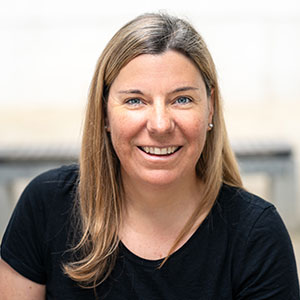
Hi ich bin Katrin!
I'm Katrin, I travel a lot and am a real travel expert! I am eager to explore the whole world with a Camper van or backpack. Furthermore, I founded this travel blog to share my experiences with you!
